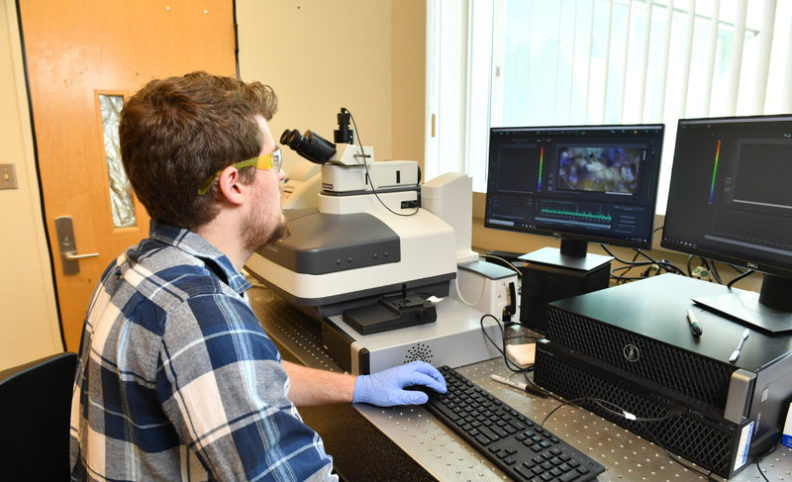
Growing up in a small mining community in Michigan, Travis Olds descended from a family where mining was the lifeblood for many generations
As a boy, Olds was fascinated by the rocks and crystals that his dad would bring home in his lunch pail from the mines. He spent hours hunting for rare and striking specimens.
“I became obsessed with digging for strange and pretty crystals, and Michigan’s Upper Peninsula is a great place for a fledgling collector because there are hundreds of mines there,” he said.
Olds’ interests led him to study chemistry at Michigan Technological University. While pursuing his PhD at the University of Notre Dame, he studied the radioactive elements uranium and neptunium.
“Uranium had a peculiar beauty that I fell in love with. When found in nature many of its crystals have strikingly yellow and green colors,” he said.
“Often rocks containing these exotic minerals just stand out from the rest.”
Travis Olds
Now a postdoctoral scholar at Washington State University, Olds is building a career from his childhood love of finding unusual minerals. He discovered and named 18 new minerals, many of which contain uranium. He’s hunted underground for them all over the world from the Czech Republic to the deserts of Southern Utah, and even the drawers of very old mineral collections, where sometimes new minerals can be found hiding.
On one expedition in the Jáchymov region of the Czech Republic, Olds descended with his colleagues hundreds of meters into old shafts that once provided uranium ore for the Soviet nuclear program. They were equipped with ultraviolet flashlights, hammers, chisels and wore filter masks to shield themselves against radioactive particles. The team carried radiation counters, and safety meters that show oxygen, carbon monoxide, hydrogen sulfide and combustible gases levels.
Dangerous levels of radon tend to accumulate in the air and water in such deep mines, Olds said.
“When underground we’re constantly absorbing radiation from radon and leftover uranium ore in the mine,” he said. “It’s dangerous work but worth the risk to develop a better understanding of uranium chemistry and behavior in the environment,” he added.

Shining his UV flashlight, Olds looks for crystals that give off a spooky glow, known as fluorescence, when hit by ultraviolet light – often a sign of uranium minerals. Even without UV light, rocks containing new minerals look different to the trained eye, said Olds.
“Often rocks containing these exotic minerals just stand out from the rest. Color and crystal shape are often the first indication you might have found something new,” he said.
Collecting everything they find interesting in large cardboard boxes, the team takes their finds back to the lab to analyze it in detail. In 2017, Olds led the team that discovered ewingite, the most structurally complex mineral known on earth. Whereas most minerals in the Earth’s crust are structurally simple, ewingite has a very large unit cell – the building block of all minerals – that contains nearly 3000 atoms.
If Olds suspects that he has found a previously unknown mineral, he tries to isolate a pure crystal of it. He then uses a technique called single-crystal X-ray diffraction to determine the structure.
If the structure doesn’t match that of any previously known mineral, then it is “new,” and can be given a unique name. Olds compiles the physical and chemical data of the new mineral into a proposal sent to the Commission on New Minerals, Nomenclature and Classification of the International Mineralogical Association, who then vote on the name and soundness of the classification.

He has named minerals he discovered after the physicist Richard Feynman- feynmanite- and for the unique paddle wheels found in the structure of paddlewheelite. He also named the mineral redcanyonite after Red Canyon in Utah where it is found, the site of an ancient ocean where Olds and his colleagues have made multiple mineral discoveries.
Since coming to WSU in 2017, Olds is continuing his work with minerals and nuclear materials, working with John McCloy, a professor in the School of Mechanical and Materials Engineering. The researchers are looking ways to safely store and dispose of nuclear waste. They are studying how uranium dioxide, a major component of nuclear fuel, behaves under the conditions expected in a geological nuclear waste repository such as the one proposed at Yucca Mountain in Nevada.
“I’m proud to bring my experience with uranium chemistry and mineralogy to my research group at WSU, where we’re at the forefront of efforts to tackle the problem of nuclear waste,” said Olds.